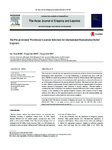The Pre-positioned Warehouse Location Selection for International Humanitarian Relief Logistics
| dc.contributor.author | Roh, SY | |
| dc.contributor.author | Shin, YR | |
| dc.contributor.author | Seo, YJ | |
| dc.date.accessioned | 2019-01-21T14:30:43Z | |
| dc.date.available | 2019-01-21T14:30:43Z | |
| dc.date.issued | 2018-12-01 | |
| dc.identifier.issn | 2092-5212 | |
| dc.identifier.issn | 2352-4871 | |
| dc.identifier.uri | http://hdl.handle.net/10026.1/13189 | |
| dc.description.abstract |
© 2018 This study aims to identify the most appropriate pre-positioned warehouse location for international humanitarian relief organisations. A two-step methodology is structured using fuzzy AHP and fuzzy TOPSIS to evaluate pre-positioned warehouse locations for humanitarian relief organisations. The empirical case study analysis of a humanitarian relief organisation is conducted to illustrate the use of the proposed framework for ranking alternative locations. This framework provides a more accurate, effective, and systematic decision support tool for stepwise implementation of warehouse location selection in humanitarian relief operations to increase efficiency. National stability is considered the most crucial factor for warehouse selection followed by host country cooperation. Location A was identified as the optimal warehouse location, with Locations D and E being relatively close. However, the organisation operates at Location A due to the national stability and government incentives such as land costs and customs exemption. | |
| dc.format.extent | 297-307 | |
| dc.language | en | |
| dc.language.iso | en | |
| dc.publisher | Elsevier | |
| dc.subject | Humanitarian Relief Organisation | |
| dc.subject | Pre-positioned Warehouse | |
| dc.subject | Fuzzy AHP | |
| dc.subject | Fuzzy TOPSIS | |
| dc.title | The Pre-positioned Warehouse Location Selection for International Humanitarian Relief Logistics | |
| dc.type | journal-article | |
| dc.type | Article | |
| plymouth.issue | 4 | |
| plymouth.volume | 34 | |
| plymouth.publication-status | Published | |
| plymouth.journal | Asian Journal of Shipping and Logistics | |
| dc.identifier.doi | 10.1016/j.ajsl.2018.12.003 | |
| plymouth.organisational-group | /Plymouth | |
| plymouth.organisational-group | /Plymouth/Faculty of Arts, Humanities and Business | |
| plymouth.organisational-group | /Plymouth/Faculty of Arts, Humanities and Business/Plymouth Business School | |
| plymouth.organisational-group | /Plymouth/REF 2021 Researchers by UoA | |
| plymouth.organisational-group | /Plymouth/REF 2021 Researchers by UoA/UoA17 Business and Management Studies | |
| plymouth.organisational-group | /Plymouth/Users by role | |
| plymouth.organisational-group | /Plymouth/Users by role/Academics | |
| dcterms.dateAccepted | 2018-11-19 | |
| dc.rights.embargodate | 2019-11-27 | |
| dc.identifier.eissn | 2352-4871 | |
| dc.rights.embargoperiod | Not known | |
| rioxxterms.versionofrecord | 10.1016/j.ajsl.2018.12.003 | |
| rioxxterms.licenseref.uri | http://www.rioxx.net/licenses/all-rights-reserved | |
| rioxxterms.licenseref.startdate | 2018-12-01 | |
| rioxxterms.type | Journal Article/Review |


